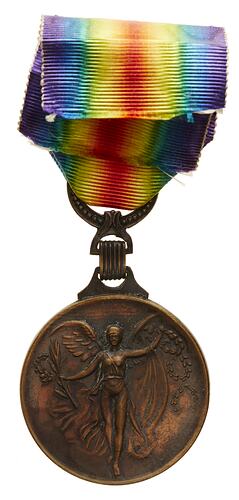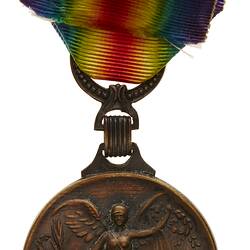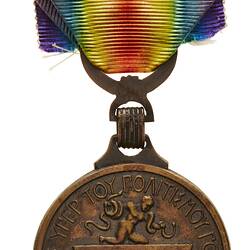Summary
Victory Medal 1914-1918, unnamed as issued, in Greece, 1920.
At the end of the First World War the Allies resolved that, if they wished to issue a Victory Medal (only China and Montenegro did not), it would share a common feature of a depiction of Victory on the obverse and a ribbon of red, yellow, green, blue and violet merged into a rainbow pattern - both combining all national colours and symbolising the end of conflict).
The other Allied countries that issued Victory medals were: Belgium, Brazil, Cuba, Czechoslovakia, France, Great Britain, Italy, Japan, Portugal, Romania, Thailand, Union of South Africa and the United States of America.
The Greek Victory Medal was established by Law number 2481 on 22 September 1920. The criteria for Army and Naval personnel was established by Royal Decree on 6 October 1920. Personnel eligible were those that served a minimum period of service of three months at the front or were wounded in action, died of wounds, or were killed in action. For Naval personnel the criterion for award was at least one year of service between 14 June 1917 and 25 November 1918. Approximately 200,000 medals were issued.
Obverse Description
Figure of Victory advancing to the front, wings spread; in her right hand she holds a palm branch and laurel wreath; with her left she distributes wreaths to the victors.
Reverse Description
Hercules as a child fighting snakes on a plaque with the names of the Allied Nations in Greek; around (in Greek) 'MEGAS YPEP TOY POLITISMOY GOLEMOS'; in exergue, '1914-1918'.
Edge Description
Plain.
More Information
-
Collecting Areas
-
Acquisition Information
Transfer from National Gallery of Victoria (NGV), 15 Mar 1976
-
Date Issued
1920 AD
-
Issued By
-
Inscriptions
Reverse: 'MEGAS YPEP TOY POLITISMOY GOLEMOS'; in exergue, '1914-1918'. Plaque contains names of Allied Nations in Greek.
-
Material
Bronze
-
Axis
12
-
Classification
-
Category
-
Discipline
-
Type of item
-
Overall Dimensions
37 mm (Outside Diameter)
-
Shape
Round with loop and ribbon
-
References
References: [Link 1]
-
Keywords


